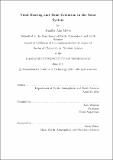Tidal heating and tidal evolution in the solar system
Author(s)
Meyer, Jennifer Ann
DownloadFull printable version (1.976Mb)
Other Contributors
Massachusetts Institute of Technology. Dept. of Earth, Atmospheric, and Planetary Sciences.
Advisor
Jack Wisdom.
Terms of use
Metadata
Show full item recordAbstract
In this thesis, we examine the effects of tidal dissipation on solid bodies in application and in theory. First, we study the effects of tidal heating and tidal evolution in the Saturnian satellite system. We constrain the equilibrium heating of Enceladus to be less than 1.1(18000/QS) GW, where QS is the tidal quality factor of Saturn. The constraint on the heat flow is calculated from simple conservation of energy and angular momentum arguments and does not depend on the internal parameters of the satellites. We then look for dynamical disequilibrium by constructing a resonance model, tested by n-body integrations, to establish a consistent resonance history for Mimas, Enceladus, and Dione. We find that Enceladus is at or near equilibrium in its current 2:1 mean motion resonance with Dione. We also look for thermal disequilibrium using the oscillation model of Ojakangas and Stevenson (1986) [Icarus 66, 341-358]. We find that Enceladus does not experience oscillations in heat flow for any choice of parameters. We conclude that the most likely explanation for Enceladus' anomalous heat flow is a QS lower than 18,000, which implies either time or frequency dependent dissipation for Saturn. Next, we create a coupled thermal-orbital model for the early evolution of the Moon. We compute the tidal heating in a dissipative lid overlying a magma ocean and the associated tidal evolution of the lunar orbit. We find that moderately high orbital eccentricities can be obtained, but show that the nonhydrostatic shape of the Moon cannot be explained by the shape solution of Garrick-Bethell et al. (2006) [Science 313, 652-655]. First, the orbit corresponding to the shape solution cannot be reached without stretching the tidal dissipation in the Earth to unphysically large values. Second, we show that the Moon will either crack or deform following the epoch of the shape solution and cannot maintain the shape until the present. We continue our study of the Moon by considering the evolution of the precession of the lunar core as the Moon tidally evolves in its orbit. Early on in the Moon's history, we show that inertial coupling will force the spin axis of the core to precess along with the spin axis of the mantle. The coupling precludes a lunar dynamo before the Moon reaches a semimajor axis of 26.0-29.0 Earth radii. We also note that the Cassini transition happens after inertial coupling has weakened enough to allow the core to precess independently. The time of the Cassini transition is therefore a promising epoch for the existence of a powerful lunar dynamo. Finally, we present a new formulation of tides on solid bodies. Tidal deformations are modeled as the excitation of elastic modes. We derive general expressions for tidal heating, despinning, semimajor axis change, and eccentricity change for zero-obliquity bodies with a perturber on a non-inclined, eccentric orbit. We then specialize these equations to the constant time lag model and confirm our theory using the classical expressions.
Description
Thesis (Ph. D.)--Massachusetts Institute of Technology, Dept. of Earth, Atmospheric, and Planetary Sciences, 2011. This electronic version was submitted by the student author. The certified thesis is available in the Institute Archives and Special Collections. Cataloged from student submitted PDF version of thesis. Includes bibliographical references (p. 193-198).
Date issued
2011Department
Massachusetts Institute of Technology. Department of Earth, Atmospheric, and Planetary SciencesPublisher
Massachusetts Institute of Technology
Keywords
Earth, Atmospheric, and Planetary Sciences.